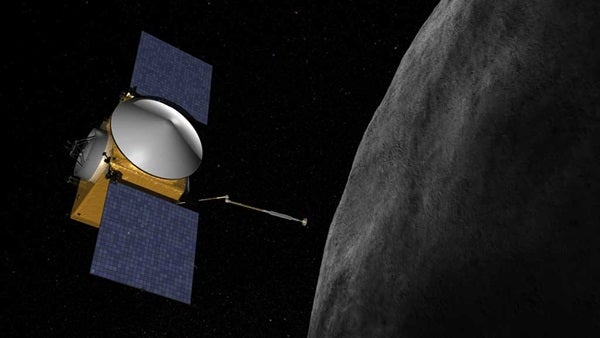NASA’s Origins-Spectral Interpretation-Resource Identification-Security-Regolith Explorer (OSIRIS-REx) spacecraft will visit the asteroid now called Bennu, named after an important ancient Egyptian avian deity. OSIRIS-REx is scheduled to launch in 2016, rendezvous with Bennu in 2018, and return a sample of the asteroid to Earth in 2023.
The name for the carbon-rich asteroid, designated in the scientific community as (101955) 1999 RQ36, is the winning entry in an international student contest. Nine-year-old Michael Puzio suggested the name because he imagined the Touch-and-Go Sample Mechanism (TAGSAM) arm and solar panels on OSIRIS-REx look like the neck and wings in drawings of Bennu, which Egyptians usually depicted as a gray heron. Puzio wrote that the name suits the asteroid because it means “the ascending one,” or “to shine.”
TAGSAM will collect a sample from Bennu and store it for return to Earth. The sample could hold clues to the origin of the solar system and the source of water and organic molecules that may have contributed to the development of life on Earth. The mission will be a vital part of NASA’s plans to find, study, capture, and relocate an asteroid for exploration by astronauts. NASA recently announced an asteroid initiative proposing a strategy to leverage human and robotic activities for the first human mission to an asteroid while also accelerating efforts to improve detection and characterization of asteroids.
“There were many excellent entries that would be fitting names and provide us an opportunity to educate the world about the exciting nature of our mission,” said Dante Lauretta of the University of Arizona in Tucson. “The information about the composition of Bennu and the nature of its orbit will enable us to explore our past and better understand our future.”
More than 8,000 students, all younger than 18, from more than 25 countries entered the “Name that Asteroid!” contest last year. Each contestant submitted one name with a maximum of 16 characters and a short explanation for the name.
The contest was a partnership with The Planetary Society in Pasadena, California; the Massachusetts Institute of Technology Lincoln Laboratory in Lexington, Massachusetts; and the University of Arizona. The partners assembled a panel to review the submissions and submit a top choice to the International Astronomical Union (IAU) Committee for Small Body Nomenclature. The IAU is the governing body that officially names a celestial object.
“Bennu struck a chord with many of us right away,” said Bruce Betts from The Planetary Society. “While there were many great entries, the similarity between the image of the heron and the TAGSAM arm of OSIRIS-REx was a clever choice. The parallel with asteroids as both bringers of life and as destructive forces in the solar system also created a great opportunity to teach.”
The Lincoln Near Earth Asteroid Research Program survey team discovered the asteroid in 1999, early in NASA’s Near-Earth Objects Observation Program, which detects and catalogs near-Earth asteroids and comets.
“The samples of Bennu returned by OSIRIS-REx will allow scientists to peer into the origin of the solar system and gain insights into the origin of life,” said Jason Dworkin, from NASA’s Goddard Space Flight Center in Greenbelt, Maryland.










